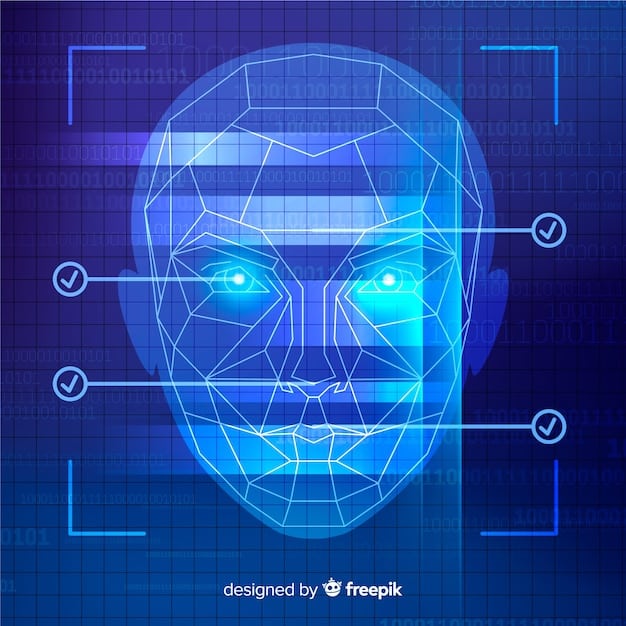Ethical Concerns of Facial Recognition in US Law Enforcement

The use of facial recognition technology by US law enforcement raises significant ethical concerns regarding privacy, civil liberties, potential for bias, and the urgent need for robust regulatory frameworks to safeguard democratic values.
In an era defined by rapid technological advancement, few innovations present as many complex societal dilemmas as facial recognition technology. Its deployment by US law enforcement agencies, touted as a powerful tool for public safety, simultaneously sparks intense debate regarding its profound implications for individual rights and freedoms. This article delves into the multifaceted ethical concerns surrounding the widespread adoption of facial recognition in American policing, exploring the delicate balance between security and liberty that this technology challenges.
The Pervasive Reach of Facial Recognition
Facial recognition technology, once confined to science fiction, has now become a reality, deeply integrated into various facets of modern life. Its application by law enforcement in the United States exemplifies a powerful shift towards data-driven policing, promising increased efficiency in crime solving and prevention. However, this promising facade conceals a complex web of ethical challenges that demand closer scrutiny and public discourse.
The technology works by mapping unique facial features, converting them into a numerical code, and then comparing these codes against extensive databases. These databases often include mugshots, drivers’ license photos, and even images scraped from social media and public cameras. The sheer breadth of data collection and the speed at which it can be analyzed present an unprecedented level of surveillance capability.
Expanding Surveillance Capabilities
The ability of facial recognition systems to identify individuals in real-time from vast distances, often without their knowledge or consent, represents a significant expansion of governmental surveillance powers. This capability moves beyond traditional forms of investigation, where probable cause is typically required for searches. With facial recognition, entire populations can be monitored, creating a chilling effect on public spaces and free assembly.
- Real-time Tracking: Law enforcement can potentially track individuals’ movements across cities and public spaces.
- Passive Identification: Unlike fingerprinting, identification occurs without active participation from the subject.
- Database Expansion: Constant growth of image databases, often from non-criminal sources, fuels broader surveillance.
The ubiquity of cameras in urban environments, combined with this technology, transforms every public interaction into a potential point of identification and monitoring. This shift fundamentally alters the expectation of privacy in public, a concept long held as a cornerstone of democratic societies.
Concerns arise from how this data is stored, who has access to it, and for how long. Without clear regulations, the potential for misuse, hacking, or unauthorized access to sensitive biometric data is substantial. The implications extend beyond immediate law enforcement applications, touching upon wider issues of data security and governance. This pervasive reach establishes a new paradigm in the relationship between citizens and the state, necessitating robust ethical guidelines.
Erosion of Privacy and Civil Liberties
At the heart of the ethical debate surrounding facial recognition in US law enforcement lies its profound impact on privacy and civil liberties. The Fourth Amendment of the US Constitution protects citizens from unreasonable searches and seizures, generally requiring a warrant based on probable cause. However, facial recognition challenges this traditional legal framework, as it allows for widespread, passive data collection without individual suspicion.
The ability of law enforcement to identify people in public spaces without their consent raises fundamental questions about what it means to be truly anonymous in society. This constant potential for identification can lead to a “chilling effect,” where individuals may self-censor their activities, expressions, and associations for fear of being monitored or flagged, even if they are engaging in lawful activities.
The Right to Anonymity in Public
Traditionally, the expectation of anonymity in public spaces has been a de facto right, allowing individuals to move freely without being constantly identified or tracked. Facial recognition technology effectively eliminates this anonymity, transforming public areas into zones of constant potential identification.
- Loss of Unidentified Movement: Every stroll, protest, or public gathering becomes a potential identification event.
- Behavioral Changes: Awareness of being constantly watched can alter individual and collective behavior.
- Data Trail: Creates a persistent digital record of movements and associations, which can be aggregated over time.
This persistent surveillance can stifle dissent, discourage participation in protests, and undermine the very essence of a free society where individuals should not fear government scrutiny for their lawful actions. The philosophical underpinning of privacy is the right to control one’s personal information, and facial recognition fundamentally undermines this control.
Furthermore, the lack of transparency regarding how and when facial recognition is used by law enforcement agencies exacerbates these concerns. Citizens often have no way of knowing if their image is being captured, analyzed, or stored, nor do they have recourse to challenge such collection. This opacity prevents public oversight and accountability, making it difficult to assess the true scope and impact of the technology on civil liberties.

The Peril of Bias and Discrimination
One of the most pressing ethical concerns surrounding facial recognition technology in US law enforcement is its documented propensity for bias and discrimination. Numerous studies have revealed that these systems are significantly less accurate at identifying individuals from certain demographic groups, particularly women, people of color, and older individuals. This inherent bias is not a flaw in implementation; it’s often a reflection of the datasets used to train these algorithms, which may lack diversity.
When biased technology is deployed in law enforcement, it can exacerbate existing systemic inequalities. Higher error rates for specific demographics mean that these groups are disproportionately likely to be misidentified, leading to false arrests, wrongful accusations, and undue scrutiny. This not only undermines trust in law enforcement but can also have devastating consequences for individuals caught in the crosshairs of flawed technology.
Disparate Impact on Marginalized Communities
The disparate impact of biased facial recognition technology on marginalized communities is a critical ethical failure. Communities that are already over-policed or have historically faced discrimination are likely to bear the brunt of these inaccuracies. This can contribute to a cycle of suspicion and increased surveillance, further entrenching systemic biases.
- Higher False Positives: Increased likelihood of misidentification for women and people of color.
- Exacerbated Racial Profiling: Technology can amplify existing human biases in policing practices.
- Erosion of Trust: Undermines confidence in fair and equitable law enforcement.
For example, a misidentification could lead to an individual being stopped, questioned, or even arrested unnecessarily, causing significant emotional distress, financial burden, and damage to their reputation. Even if eventually cleared, the incident can leave a lasting scar. The racial and gender biases embedded in the technology are not merely technical glitches; they are ethical shortcomings that contribute to social injustice.
Addressing these biases requires not only more diverse training datasets but also a fundamental reevaluation of whether such technology, with its known limitations, should be used in sensitive law enforcement contexts at all. The ethical imperative is to ensure that technological advancements do not inadvertently become tools of oppression, perpetuating and amplifying societal inequalities. Without unbiased systems, the promise of fairness and justice remains elusive.
Lack of Transparency and Accountability
A significant ethical challenge in the deployment of facial recognition technology by US law enforcement is the pervasive lack of transparency and accountability. Many agencies adopt and use these systems without adequate public disclosure, clear policies, or independent oversight. This opacity creates a fertile ground for misuse, prevents informed public debate, and makes it incredibly difficult to address concerns when they arise.
Citizens often have no knowledge of which agencies are using facial recognition, how the technology is being procured, what data is being collected and stored, or how decisions are made based on its outputs. This secrecy undermines democratic principles, as the public cannot hold its government accountable for practices it knows little about.
Opaque Acquisition and Deployment
The process by which law enforcement agencies acquire and deploy facial recognition systems is frequently shrouded in secrecy. Contracts with private vendors are often not publicly scrutinized, and agencies may not disclose the specific capabilities or limitations of the technologies they are using. This lack of transparency extends to the actual deployment, where citizens are typically unaware if they are being monitored.
- Secret Procurement: Agencies can purchase systems without public knowledge or debate.
- Absence of Public Policy: Little to no public input on the rules governing technology use.
- Limited Oversight: Absence of independent bodies to review or audit system deployment and impact.
Without clear guidelines and public scrutiny, there is a substantial risk of scope creep, where the technology’s use gradually expands beyond its initial stated purpose. For instance, a system acquired for serious criminal investigations might subtly be repurposed for minor infractions or general surveillance, without public notification or consent.
Furthermore, accountability mechanisms are often absent or insufficient. If a facial recognition system leads to a false identification or wrongful arrest, the process for challenging such an outcome is unclear, and mechanisms for redress are underdeveloped. This lack of clear accountability pathways leaves individuals vulnerable and reinforces the power imbalance between citizens and agencies wielding such powerful technology. To truly ensure ethical use, transparency from acquisition to deployment, coupled with robust accountability, is paramount.
Potential for Misuse and Abuse
Beyond accidental biases or privacy infringements, facial recognition technology harbors a significant ethical danger: the potential for deliberate misuse and abuse by those in power. History is replete with examples of powerful surveillance tools being turned against citizens, political opponents, or minority groups. Facial recognition, with its ability to identify and track individuals without their knowledge, presents an unprecedented capacity for such abuse.
The lack of a comprehensive federal regulatory framework for facial recognition in the US amplifies this risk. Without clear legal boundaries, oversight mechanisms, and independent auditing, the temptation to leverage this technology for purposes beyond public safety—such as political targeting, suppression of dissent, or discriminatory enforcement—becomes a serious concern. This potential for abuse threatens the foundational principles of a democratic society.
From Crime Fighting to Social Control
While proponents argue that facial recognition is a crucial tool for fighting serious crime, its broad application could easily pivot towards social control. The ability to identify participants in protests, monitor individuals expressing dissenting views, or even compile lists of perceived “undesirables” is a deeply troubling prospect that could erode fundamental freedoms like freedom of speech and assembly.
- Political Targeting: Identification of protesters or political activists.
- Suppression of Dissent: Discouraging public assembly through widespread surveillance.
- Chilling Effect: Fear of surveillance leads to self-censorship.
Moreover, the absence of strict data retention policies means that biometric data collected could be stored indefinitely, creating a permanent surveillance record. This data could be vulnerable to breaches, or worse, could be exploited for purposes unforeseen at the time of its collection. The aggregation of such data offers a detailed, intrusive profile of individuals, opening doors to highly targeted surveillance or even harassment.
The ethical imperative here is to establish robust legal safeguards that prevent the technology from becoming an instrument of oppression rather than one of justice. This includes strictly limiting its permissible uses, demanding strong judicial oversight, and implementing criminal penalties for misuse. Without such protections, the risk of facial recognition evolving from a law enforcement tool into a system of pervasive social control remains a palpable and alarming threat to civil liberties.
The Imperative for Regulation and Oversight
Given the array of ethical concerns—from privacy erosion and civil liberties infringements to inherent biases and the potential for misuse—the overwhelming conclusion is the urgent need for comprehensive regulation and robust oversight of facial recognition technology in US law enforcement. The current patchwork of state and local policies, alongside a profound lack of federal legislation, leaves significant gaps, allowing for inconsistent application and insufficient protection of civil rights.
A proactive and well-considered regulatory framework is essential to strike a necessary balance between public safety and individual freedoms. Such regulation must go beyond mere guidelines; it must establish clear legal boundaries, mandate transparency, ensure accountability, and provide meaningful avenues for redress when errors or abuses occur. Waiting until the technology is fully entrenched and its negative impacts fully realized is a precarious approach.
Key Regulatory Principles
Any effective regulatory framework must be built upon several core principles that prioritize human rights and democratic values. These principles should guide the development and implementation of policies, ensuring that technological advancement serves society rather than undermines it. This involves a multi-pronged approach that addresses technology, policy, and human rights.
- Strict Limitations on Use: Define specific, narrow circumstances where facial recognition is permissible (e.g., serious felonies, not minor infractions).
- Consent and Notification: Where feasible, require consent or at least clear public notification of surveillance.
- Bias Auditing and Mitigation: Mandate independent, transparent audits of systems for accuracy and bias, with clear plans for mitigation.
- Transparency and Accountability: Require public disclosure of technology use, data retention policies, and establish clear accountability mechanisms for misuse.
- Independent Oversight: Create independent bodies with the authority to review, audit, and regulate the use of facial recognition by law enforcement.
- Data Security and Retention: Implement stringent rules for data protection and limits on how long biometric data can be stored.
Furthermore, regulation should address the vendors of facial recognition technology, ensuring that they are transparent about their systems’ capabilities and limitations. Holding both agencies and manufacturers accountable for the ethical deployment and performance of these systems is crucial. The public’s trust in law enforcement, and indeed in government, hinges on the careful and ethical management of powerful surveillance technologies like facial recognition.
Ultimately, the imperative is to establish a future where technology enhances safety without eroding the fundamental freedoms that define a democratic society. This requires ongoing dialogue among policymakers, civil liberties advocates, technology experts, and the public to craft regulations that are both effective and ethically sound. The ethical implications are too significant to leave to unchecked technological expansion.
| Key Concern | Brief Description |
|---|---|
| 🔒 Privacy Erosion | Eliminates anonymity in public, creating constant surveillance potential without consent. |
| ⚖️ Bias & Discrimination | Higher error rates for marginalized groups lead to disproportionate misidentification and unjust scrutiny. |
| 🕵️♂️ Transparency Vacuum | Lack of public disclosure on technology use, policies, and accountability mechanisms. |
| ⛓️ Potential for Abuse | Risk of systems being used for political targeting, suppression of dissent, or social control. |
Frequently Asked Questions About Facial Recognition and Law Enforcement
▼
No, there is currently no comprehensive federal law specifically regulating facial recognition technology in the US. This absence creates a fragmented landscape where states and localities implement varying policies, leading to inconsistencies in privacy protection and oversight.
▼
Facial recognition can significantly chilling effect on civil liberties, particularly the right to protest. The fear of being identified, tracked, and having one’s participation recorded can discourage individuals from exercising their First Amendment rights to free speech and assembly, undermining democratic participation.
▼
Bias in facial recognition refers to its disproportionate inaccuracy in identifying certain demographic groups, notably women and people of color. This is a concern because it can lead to higher rates of false positives and misidentifications for these groups, potentially resulting in wrongful arrests or increased scrutiny, exacerbating existing inequalities.
▼
Currently, in many jurisdictions across the US, law enforcement can use facial recognition without obtaining a warrant, especially when using publicly available images or real-time surveillance in public spaces. This practice raises significant Fourth Amendment concerns regarding unreasonable searches and seizures, challenging traditional notions of privacy.
▼
Various steps are underway, including legislative efforts at state and local levels to ban or limit facial recognition, advocacy by civil liberties groups, and calls from tech companies for federal regulation. Researchers are also working on methods to improve accuracy and mitigate bias, though comprehensive solutions are still debated.
Conclusion
The ethical concerns surrounding the use of facial recognition technology by US law enforcement are profound and multifaceted, striking at the very core of individual privacy, civil liberties, and the principles of justice. While the technology offers compelling promises for enhancing public safety, its current deployment largely lacks the necessary legal and ethical safeguards. The documented biases, the potential for widespread surveillance, and the inherent opacity in its use demand urgent attention. Moving forward, the imperative is to foster a society where technological advancement serves humanity, rather than inadvertently restricting its freedoms. This requires a robust, transparent, and accountable regulatory framework that prioritizes human rights while navigating the complex landscape of innovation.





